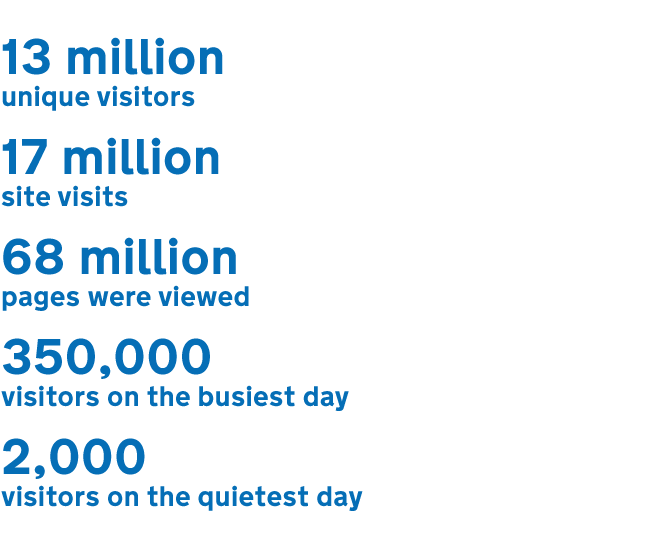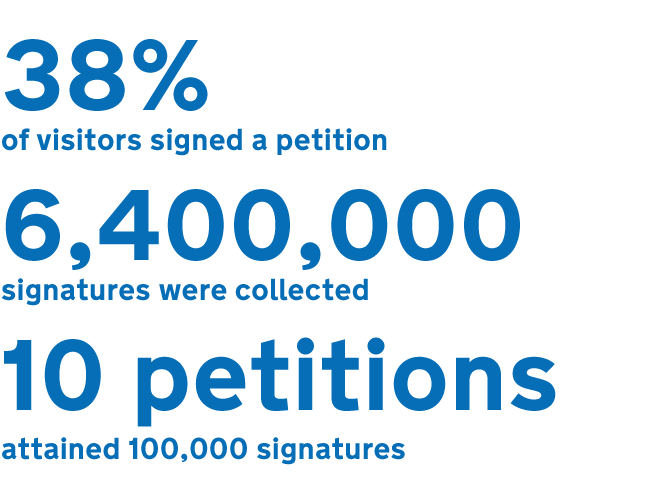E-petitions is the very first product delivered by GDS and last week it celebrated its first birthday. Pete Herlihy, product owner for e-petitions reviews the year in numbers.
It’s been an eventful and productive first 12 months, both in terms of how widespread the use of e-petitions has become and also in terms of the iterations we’ve made to the service during that time.
A year on from the first public release, we have an opportunity to look back and see how e-petitions has been doing, by highlighting some of the numbers that provide insights into how the service is used and what its impact is on Parliament and the democratic process.
The petitioners
Looking at the numbers above and the list of petitions , the range of issues that motivate people to start an e-petition is striking. Even discounting the high proportion of e-petitions that are rejected for not meeting the service’s terms and conditions (duplicates, things outside Government control etc), there is still an average of 1,300 valid e-petitions being started every month.
The visitors
The annual number of visitors and the number of visits they each make amount to some very large numbers, far greater that some major departmental websites for instance. The unique visitors equate to more than a quarter of the UK’s population over the age of 16 having visited the e-petitions website.
There is a hint in the month to month breakdown below, of the large fluctuations in visitor numbers on any given day. The chart also shows just how variable the demand on e-petitions can be - propelled by real world events.
The large peak in the chart was primarily due to the huge support for a petition raised during the London riots in August 2011. Whether or not you agree with the sentiment of the petition, these numbers demonstrate the importance of having a forum for people to have their say and interact with politics.
The signatories
With over a third of visitors taking action and signing an e-petition, this represents the equivalent of collecting 12 signatures every minute since the service launched.
Ten e-petitions have passed the 100,000 signature threshold, making them eligible for debate in the House of Commons. Of these, nine have been debated, with a debate relating to the 10th scheduled when the House of Commons returns in September 2012.
I asked the Office of the Leader of the House of Commons how well they thought e-petitions has worked in terms of public engagement with politics:
“Debates relating to e-petitions, such as that on the release of papers relating to the Hillsborough disaster, saw some of the highest viewing figures for television coverage of Parliament and have seen the Government change or clarify its position. The site has allowed people to raise issues that would have otherwise not been considered in Parliament and gain public support for their campaigns. The Government continually seeks to engage the public with all aspects of the political process, having recently launched its latest Public Reading Stage to allow people comment on laws being debated in Parliament.”
High praise indeed for a mode of participation that has been live for merely a year.
The costs

With initial delivery costs of around £90,000 and ongoing running costs of around £30,000 per annum, e-petitions is one of the cheapest government services to facilitate. The cost of e-petitons in the first year works out at 2p per transaction and it is expected that this will fall to under 1p in it’s second year and beyond.
As is the GDS way, we’ll continue to listen and iterate on e-petitions. Our next area of focus will be making it easier for petitioners to engage with MPs, especially on those petitions that may not attain the 100,000 signatures, but are still that are worth investing time in. Keep an eye on this blog for developments.





15 comments
Comment by Parliament Everywhere: designing a legislature for the 21st century | Joe Mitchell posted on
[...] the People’ site has had 5m visits. The UK’s e-petitions site has had an astonishing 13m unique visitors – equivalent to a quarter of the UK’s voting [...]
Comment by Policy, delivery, Government digital service posted on
[...] Transactions Explorer which shows the key data for all 672 Central Government transactions Aug: E-petitions birthday Sep: Delivered alpha of Student Loans Company service. Oct: Finalise the Digital Efficiency Report [...]
Comment by Digital Transformation in 2013: The strategy is delivery. Again. | Government Digital Service posted on
[...] the Civil Service Reform Plan (PDF) plus we joined OIX Jul: Launched the Transactions Explorer Aug: E-petitions birthday Sep: Delivered alpha of Student Loans Company service. Oct: Finalise the Digital Efficiency Report [...]
Comment by Happy Birthday to the Government e-petition site « thoughtful campaigner posted on
[...] site celebrated its first birthday last month, and the team at the Government Digital Services released figures about the usage in its first [...]
Comment by 'We the People' Nets More Than 3,000,000 Signatures posted on
[...] about one month earlier in the United Kingdom lured in 13 million unique visitors, according to a blog post from the U.K.’s Government Digital Service [...]
Comment by Andrea - UK eMarketing posted on
I think it would be a good idea to have a localised version for local issues rather than national. But on the other hand this may raise costs and be difficult to produce a framework to connect all authorities petitions. Is it up to the individual authority to implement systems like this?
Comment by Peter Herlihy posted on
Hi Andrea. As I understand it, local authorities are obliged to provide an online petitioning service already. MySociety (amongst others) provide very reasonably priced service that many councils use, so I don't think costs should be a significant blocker. Joining up and publishing petitioning data across local authorities will be more challenging, especially where they use different systems and data schema.
We recently open sourced the e-petitions code base (https://github.com/alphagov/e-petitions) and opened up the non-personal data that we collect via an API (http://epetitions.direct.gov.uk/faq).
Hopefully these two things will provide more options to others looking to create their own service.
Comment by Happy birthday e petitions – a year in… « Kind of Digital Exchange posted on
[...] Happy birthday e petitions – a year in…Happy birthday e-petitions – a year in numbers [...]
Comment by Fraser Henderson posted on
Looking good. What was the most common topic and most common reason for rejection?
Comment by Peter Herlihy posted on
Cheers Fraser. The petitions are just too many and varied to be able to spot the most common topics, but the top three 'responsible departments' (by number of e-petitions submitted) are Ministry of Justice, Home Office and HM Treasury. I think you can infer crime, policing, immigration and budget related issues are pretty high on the agenda.
Regarding rejection of petitions, duplication of an existing e-petition is by far the most common reason.
Comment by baragouiner posted on
When a new petition is submitted, is checking it against existing petitions automated or does a human have to scan the list before deciding whether to accept it or reject it as a duplicate?
Comment by Peter Herlihy posted on
baragouiner, there is a bit of both. When someone adds a new petition, a search is completed to show similar petitions, at this point the submitter can decide whether to continue. Once they have submitted their petition, there is then a manual (human) process to check for duplicates. It is not possible to fully automate with any fairness, as there can be quite similar petitions that are asking for quite different things.
Comment by Emma Cleary posted on
Excellent example of channel shift! i hope this is something our authority can adopt in the future for a number of services.
Comment by Peter Herlihy posted on
Thanks Emma. All eyes on Wolverhampton now!
Comment by Emma Cleary posted on
Well, we are implementing a centralised publishing model on the back of what has happened in central government so i am sure we can follow suit with other services....watch this space!